May 2006
Cajid, 2005, Caj004
http://cajid.com
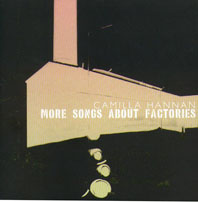 In addition to installation and cinesonic works, Camilla Hannan has been putting out tracks on various Australian sound compilations since 2001 (Document 03-Diffuse, Liquid Architecture 3 and 4). More Songs About Factories is her first full length CD. It is a deep, throbbing, rumbling work which sits well with Cajid's line-up of Thembi Soddell and Bruce Mowson.
In addition to installation and cinesonic works, Camilla Hannan has been putting out tracks on various Australian sound compilations since 2001 (Document 03-Diffuse, Liquid Architecture 3 and 4). More Songs About Factories is her first full length CD. It is a deep, throbbing, rumbling work which sits well with Cajid's line-up of Thembi Soddell and Bruce Mowson.
There is now quite a diverse field of artists working in a similar vein. Darrin Verhagen's Soft Ash (Dorobo: 1997) and Toshiya Tsunoda's influential piezoceramic microphone document, Field Recording Archive #3 – Solid Vibration (Infringitive, 2001), come to mind. Like most of these practitioners, Hannan begins with field recordings of distant industrial activities and has tweaked and remixed these to produce a set of richly smeared cycling pulses with some coiling, mildly grating additions.
Both the sonic palette and the temporal/rhythmic variation represented on More Songs commences with and eventually concludes in a minimalist vein, typical of this style of composition. By track 4 of 5, however, a series of diverse, stereophonically active, crunchy, crinkling and sharply insistent sounds have begun to both cut across and poke firmly out of the wide bed of the mix. Typewriter-ish punctuations give way to an incisor-like, repeated metallic squeal, creating an interesting dynamic as these new, more aggressive, higher frequency elements move about throughout track 4 and into the final track. As the subtitle of track 4 announces, this is an “Itchy” section, a series of very pointed sonic abrasions which break up an otherwise gently dispersed, aggregated mass of roiling materials and mild pulses. The CD ends on something intermediate between these 2 extremes as the higher frequency, prodding punctums are withdrawn, leaving a series of now much more expansive textural effects. The nature of the now foregrounded background has therefore been subtly altered and continues to be so with more overt speed and a larger acoustic space than in the somewhat more compressed and oppressive first tracks, eventually producing a loud, intense conclusion.
Amongst the many rumbling, mostly deep-tone soundscapes and altered field recordings currently available, it is becoming increasingly difficult to articulate precisely what distinguishes one from another. In Hannan's case it appears to predominantly be this alternation between wide voluminousness and compacted density. It is certainly true that the superlative sounds of Solid Vibration are hard for any artist to top, so Hannan's relative emphasis on sound design over composition may be a wise strategy (inasmuch as the 2 can really be separated within this genre). Nevertheless, Hannan certainly shows on More Songs… that she can throb and grate with the best of them, so I look forward to seeing if her earlier, more harmonic, musique-concrète approach and otherwise glancing sonic shapes might return in future releases to give her field recordings yet another level of overt distinction. In any case, this is a fine new release within a populous but still growing form.
Jonathan Marshall
Bus – Outer 6, 2005
www.bus117.com
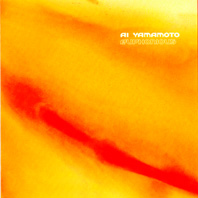 Previous Bus Gallery Outer releases have been compilations of various experimental sound artists, however the 6th in the series is a solo CD by Ai Yamamato. Japanese born, Melbourne-based Yamamoto is a well respected performer on the Australian scene, renowned for finely detailed, pretty compositions frequently accompanied by her own visuals. So this full length exploration has been keenly anticipated.
Previous Bus Gallery Outer releases have been compilations of various experimental sound artists, however the 6th in the series is a solo CD by Ai Yamamato. Japanese born, Melbourne-based Yamamoto is a well respected performer on the Australian scene, renowned for finely detailed, pretty compositions frequently accompanied by her own visuals. So this full length exploration has been keenly anticipated.
Euphonious opens with a 1 minute intro of gauze-like shimmers, quickly launching into the most pop-friendly piece, Guitarist letter, a gentle lolloping guitar loop with evolving frills on top. At the very end a single piano note and deep crackle give us a hint of darker possibilities.
Childhood (Track 4), also has popular appeal, with its overlapping vibraphone note clusters. Though the music box timbre has become the domain of Icelandic experimental pop tribes, Yamamoto's broken, intertwining melodies hang simultaneously in the air, creating beguiling polyphonies, confidently reclaiming the territory. Yamamoto also makes pretty work of the gamelan-timbre on Ai remember (Track 6), her sounds almost organic yet with a digitised edge that is constantly intriguing.
A highlight is Dreaming of swimming in emerald water (Track 7) made of midtone drones topped with melodic wisps, like high clouds forming, dissipating, reforming. New drones are introduced shifting the atmosphere into almost heavier zones which work back to resolved territory. Coming in at 4mins 33, it feels like this piece could quite happily sustain itself for 10 minutes.
Tracks 9-11 seem like a song cycle, joined together by a palette of needle sharp patterns, glassy patinas and waftier undertones that just keep us in touch with the earth. Beautifully mixed the sharpness never becomes unpleasant although it does create a sameness to the middle section of the album.
In contrast, the final 3 pieces offer the most varied explorations. Skyscraper has a majestic meditative pace, heavy on synthesizer tones, drawing inspiration from earlier electronic pop. Sky Train offers pacey, birdlike electronic trills and bleeps creating an atmosphere of excitement on the verge of agitation. The concluding track Make a wish uses a distant piano, gradually turning backwards on itself, giving a haunting sense of a shadow afterlife of the sounds.
On all the tracks Yamamoto's touch is light and considered. Her choice of timbre is her stylistic strength which only rarely becomes too samey. My only wish is for several of the pieces to be longer so that they can grow and hover a little longer on the edge of the darker places she evokes. That aside, Euphonious lives up to its title. More than simply pleasant sounding, Yamamoto offers 14 glittering aural jewels of exploratory electronica.
Gail Priest
Room40, 2004, RM406
http://www.room40.org
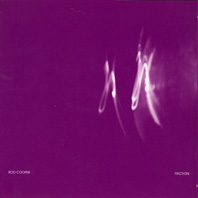 In Friction, sculptor, instrument builder and subterranean explorer Rod Cooper has taken some of his hand-built metal instruments and documented performances upon them. Here we have an artist intimately entwined with his inventions and the spaces they inhabit.
In Friction, sculptor, instrument builder and subterranean explorer Rod Cooper has taken some of his hand-built metal instruments and documented performances upon them. Here we have an artist intimately entwined with his inventions and the spaces they inhabit.
In Estuary Nocturne long bowed notes swell and overlap accompanied by a broad, complex and somewhat breathy harmonic spectrum. These dronal tones border on the edge of stability: punctuations of sharp plucking and some lesser dull knockings disturb their dark waters.
It is in the longest track, Stratum, that Cooper fully explores the possibilities of instrument, performance and space. Extending over 17 minutes it begins with machinic rattlings and vibrations, stretching from feverish rasping to gentle lulled tones. Before it ends Cooper has managed to coax, throttle and squeeze what seems to be every possible sound out of the instrument. The interplay between hard and soft, space and sound, performer and instrument, and what lies between the sounds themselves, is satisfying: what Cooper refers to as “comfort through dissonance”.
Cooper seems to be trying to bring to life some other that lies within his hand-forged instruments. At times an invocation, in some instances a “voice”, is released from his ferrous contraptions via rubbing, scraping, bowing, striking and plucking. The sonic matter is thick, extending into space, over time defining the instrument's materiality and the place in which it dwells. Mostly this definition forms the composition itself yet there is one track in particular, Mandrel, which employs variations of a 3-note motif of sharp attacks and extended decays paired with long, low buzzing notes. These 2 clusters build up a more familiar musical compositional approach than otherwise represented on the disk.
The acoustic spaces on each track seem to be similar. This has the advantage of highlighting the different qualities of instruments although notably different 'rooms' could have been an interesting addition knowing Cooper's penchant for alternative spaces, especially those of Melbourne's underground.
The overall subterranean feel of Friction and Cooper's ability to release characteristic sounds from his own intruments give the tracks a coherence and confidence only gained through experience. The watery cascade of notes delivered on the final track, Pearlite, is testament to this. This confidence also highlights the compositional structures developed over time from the capacities of each instrument. These are loosely adhered to allowing a revelatory discovery of sonic textures and intuitive percussion.
Dean Linguey
Sound Punch, 2004, Hurt-008
www.philipbrophy.com
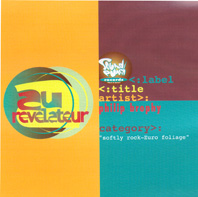 Philip Brophy has made a manifold contribution to Australian screen/sound culture as a composer, curator, critic and teacher across media (installation, CD, live performance, journals, popular forums). His Sound Punch label has released 9 CDs by Brophy and others over the last 6 years. The latest is Aurévélateur which, like Beautiful Cyborg (see review) (2002), was originally devised for live performance as a score-in this case to director Philippe Garrel's bizarre filmic critique of the bourgeois family, Le révélateur (1968). Garrel's movie largely consists of the silent flight of a family through a mostly empty, darkened landscape; a fractured retreat in terror from an unseen threat. This scenario is intended to represent the tensions and paranoias of the capitalist family. Le révélateur's startling power comes from its opacity, from the weird hyper-investment of the images which is partly created by Garrel's deliberate use of silence rather than soundtrack. It is therefore hard to see what Brophy's music might add beyond a certain banality of theme, an emotional/musical consistency, or a sense of dated historicism—not least as Brophy's broadly unified score tends to sew together Garrel's deliberately disjointed scenography.
Philip Brophy has made a manifold contribution to Australian screen/sound culture as a composer, curator, critic and teacher across media (installation, CD, live performance, journals, popular forums). His Sound Punch label has released 9 CDs by Brophy and others over the last 6 years. The latest is Aurévélateur which, like Beautiful Cyborg (see review) (2002), was originally devised for live performance as a score-in this case to director Philippe Garrel's bizarre filmic critique of the bourgeois family, Le révélateur (1968). Garrel's movie largely consists of the silent flight of a family through a mostly empty, darkened landscape; a fractured retreat in terror from an unseen threat. This scenario is intended to represent the tensions and paranoias of the capitalist family. Le révélateur's startling power comes from its opacity, from the weird hyper-investment of the images which is partly created by Garrel's deliberate use of silence rather than soundtrack. It is therefore hard to see what Brophy's music might add beyond a certain banality of theme, an emotional/musical consistency, or a sense of dated historicism—not least as Brophy's broadly unified score tends to sew together Garrel's deliberately disjointed scenography.
Like Beautiful Cyborg therefore, Aurévélateur is most satisfying if one ignores its filmic origins and considers it as a purely listening experience. At this level, Aurévélateur functions as probably the most poppy and accessible of the Sound Punch releases. With Dave Brown of Lazy and Candlesnuffer fame adding bass and guitar, and Sianna Lee vocals, Brophy's keyboard and drums come together to produce something very much akin to the revival of late punk, 'kraut-rock' and post-punk electronica which has recently been produced by Ladytron, Chicks on Speed, Life Without Buildings, Rocket Science, Franz Ferdinand and indeed too many bands to name. Brophy's melange brings forth something more of late 1960s, early 70s psychedelia and head-music to the mix than most of these other re-interpreters (the vaguely Jefferson-Airplane-like neo-lounge of Broadcast aside). In the end though, there is little that one would not hear at a good night either at the Factory during a performance of the Exploding Plastic Inevitable, the Velvet Underground or Lou Reed, or perhaps during one of the later Koolaid Acid Tests with the Grateful Dead et al. This is fine, but it is not very remarkable. In addition Brophy tries to underline the theme of Le révélateur with 2 versions of David Bowie's epic Heroes. Part of what made this song work was the sense of desperation and vocal friction in Bowie's enunciation as he begins to cry out at the finale with a wonderful technique that takes him close to a scream. Brophy by contrast sings “I wish I could swim / like dolphins can swim” in an oh-so-cool, presumably ironical, postmodern, deadpan fashion, all but eviscerating Bowie's masterpiece.
Brophy has described his recording as not so much a new score but a “riff” on Garret's film. One must therefore ask what Brophy has added to the heritage, sounds, dynamics and images of late 60s, early 70s culture with his noodlings, and conclude not all that much. Heroes aside, this CD makes for a good listen, with dirty guitar and Moe-Tucker-style drumming interspersed with loungey organ. However I would advise those seeking to add to their collection to go through Sound Punch's fantastic back catalogue before considering this particular release.
Jonathan Marshall


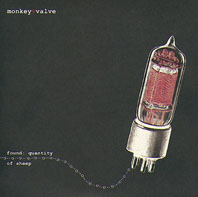 Found: Quantity of Sheep (FQS) are a self-described “experimental” rock band based in Perth who, like Set Fire to the Flames and several other contemporary instrumental groups, mix classic droney guitar rifts and melodic progressions with unusual recording techniques (vibrations and distortions in the mix, room sounds, distant mic-ing and field recordings of level crossings and other sources), studio composition and orchestrated prog rock. Although FQS' work often includes moments of noise and the odd self-important screamed vocals, the band largely eschews the melodrama of much contemporary heavy metal and industrial music. Rather, the use of warmer tones, sustained emotions—as well as cello, strings and piano—tends to place FQS' work more within the realm of composed rock with a slightly Gothic ambience.
Found: Quantity of Sheep (FQS) are a self-described “experimental” rock band based in Perth who, like Set Fire to the Flames and several other contemporary instrumental groups, mix classic droney guitar rifts and melodic progressions with unusual recording techniques (vibrations and distortions in the mix, room sounds, distant mic-ing and field recordings of level crossings and other sources), studio composition and orchestrated prog rock. Although FQS' work often includes moments of noise and the odd self-important screamed vocals, the band largely eschews the melodrama of much contemporary heavy metal and industrial music. Rather, the use of warmer tones, sustained emotions—as well as cello, strings and piano—tends to place FQS' work more within the realm of composed rock with a slightly Gothic ambience.
